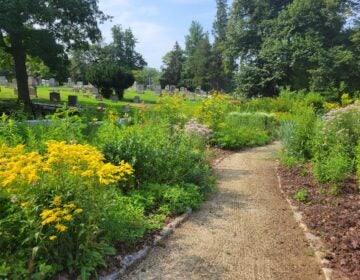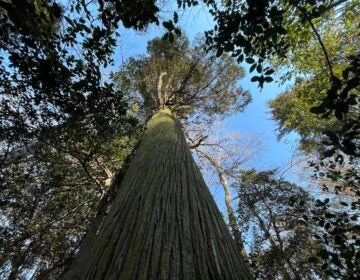Spruce up your desk with easy-to-care-for house plants!
ListenMike explains why you should not plant new bulbs over existing bulbs, how to introduce a pheasant population onto your property, why wasps can be beneficial to your garden, the benefits of introducing native plant species into your landscape and what plants you can grow at your office desk. Plus Mike speaks with Susan Spinella Sacks and Dr. Laura Toran, both faculty at Temple University, about a new project that used sheep to get rid of unwanted invasive plants.
Question of the Week:
I work at an office building – you know the type – row after row of cubicles. I’m not near a window, so I get very little natural light, but I’d still love to try and “spruce” up the place with a few plants. The problem is that I’ve had no luck with houseplants in the past—and that was with light! Can you recommend a few “OK with low light” plants for me? Thanks!
— Elyse in Center City, Philadelphia
Find out what indoor plants thrive in low-light »
Highlights from show for November 16, 2013:
Don’t plant new bulbs over existing bulbs
Lisa from Bridgeton, New Jersey has day lilies that she’d like to plant in an existing daffodil bed, and she wonders if it’s OK to plant the spring bulbs on top of the existing bulbs. Mike advises Lisa to find another place to plant her day lilies. He explains: “It is not recommended that you put other plants on top of underground bulbs. In their native habitat — these godforsaken mountains of Turkey and Afghanistan and Russia — the bulbs come up for a very short period of time during the spring when it’s warm, when the snow melts. But then very quickly spring turns to a very rugged hot and dry summer, so the bulbs disappear underground. And their DNA is programmed to not be fed, not be watered, to be underground during a blindingly hot dry summer … When we plant other plants on top of spring bulbs in the summer time to utilize their space, very often the watering and feeding of those plants can rot some or all of the bulbs underneath.”
Bringing back pheasants
Andrew from Hayworth, Illinois is calling in with questions about pheasants. He’d like to introduce a population of pheasants to his 3-acre property because although the species is native to the area, the birds are no where to be found! Mike suspects that the disappearance of pheasants can be attributed to surburban sprawl and poor agricultural practices. Mike says it sounds like Andrew has the right mix of landscaping in his for the pheasants to nest and hide, but as far as establishing a new population of birds on his property, Mike recommends contacting his state wildlife officials to inquire about protected animal programs. It may be possible to tap state resources to create a protected wildlife area for these birds.
Special guests Susan Spinella Sacks and Dr. Laura Toran
Mike speaks with Susan Spinella Sacks and Dr. Laura Toran, both faculty at Temple University, about a new partnership taking place between Temple’s Center for Sustainable Communities and Upper Dublin Township that used sheep to get rid of unwanted invasive plants. This experiment took place in Upper Dublin township (PA) where a flock of Katahdin sheep were moved from storm water basin to storm water basin as they ate all of the invasive plants like Phragmites and Wineberry. They did a great job and didn’t pollute the environment while doing it.
“The earlier you introduce the sheep into the basins and they get at these plants very early in the life cycle of the plant, the more likely they are to completely rid the problem.”
Susan Spinella Sacks
-

Photo by Flickr user photogramma1
Wasps might be doing your garden a favor
Paul from Columbus, Georgia trouble with bees and wasps. He wants to start a new garden, but the stinging insects are taking over! Mike explains that while wasps are aggressive and aren’t the friendliest of garden companions, they aren’t all bad. Mike explains: “Now I will tell you, as someone who wants to establish a garden, when these wasps aren’t building their nests or staring you down, they are eating massive amounts of pest caterpillars. So they are absolutely beneficial for a garden, and the further south you get, the more beneficial.”
-

Photo by Flickr user Ellen F
Bring home the birds
Mike from Newtown Square, Pennsylvania called in to follow up on a previous conversation about relying on birds to help with pest management. He was happy to hear that the conversation encouraged using native plants to build a sustainable ecosystem service. Mike McGrath agreed, saying: “Yes, and they’re beautiful birds too! The wren is this just wonderful little bird. There’s a couple of them — wren, the titmouse, the chickadee — that not only consume their own weight in insects pests almost everyday, but they really enjoy living near people. … and I look at other people artificially feeding birds and I think, you know, What are you doing?! These birds are like vacuum cleaners; they will eat every pest off your outdoor plants. And instead of giving them bagged food, why not give them a chemical-free habitat? Why not give them a lot of plants that provide natural food and shelter and some nesting boxes?”
WHYY is your source for fact-based, in-depth journalism and information. As a nonprofit organization, we rely on financial support from readers like you. Please give today.






